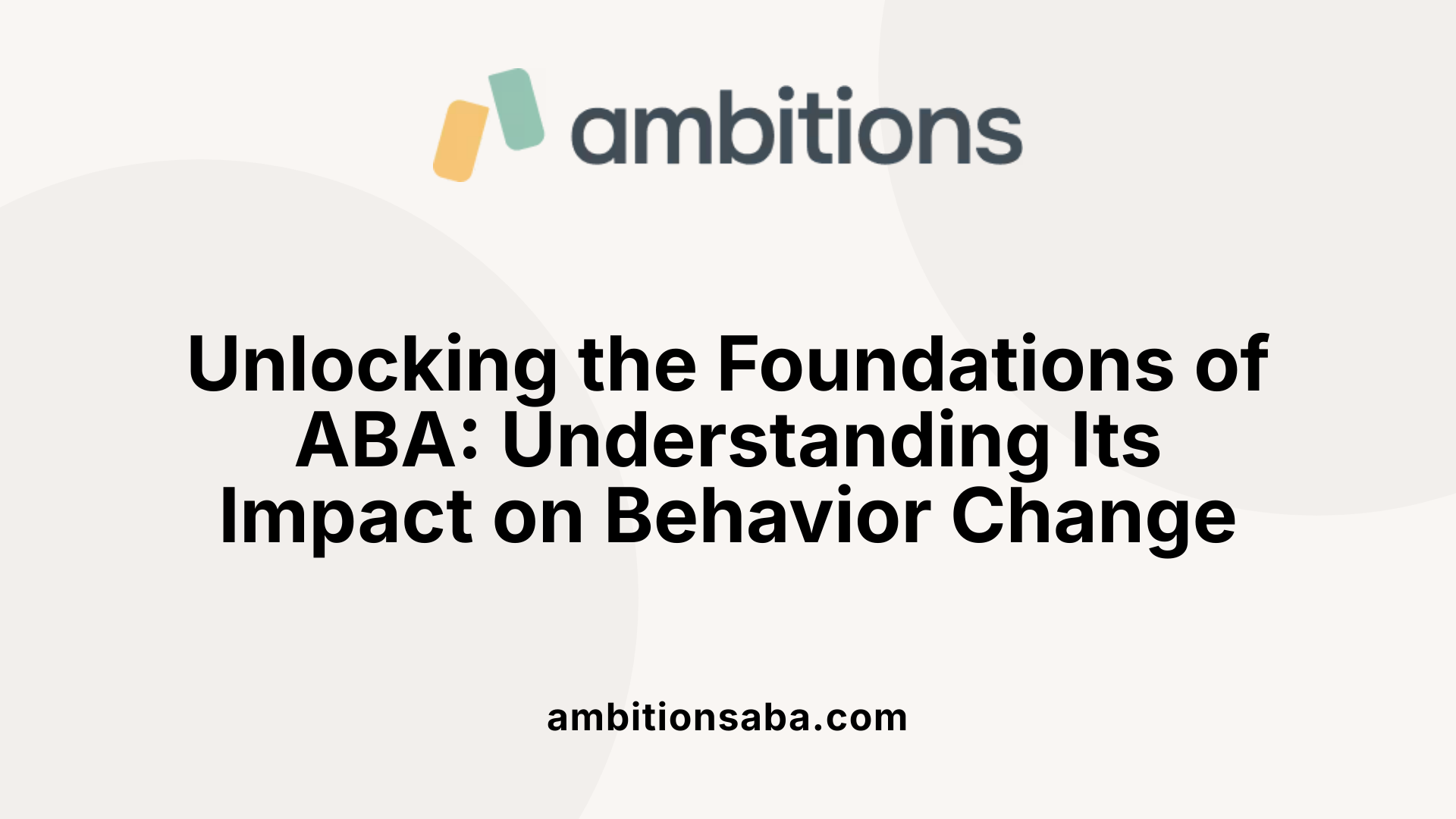Effective Strategies for Goal Setting in ABA Therapy
Introduction to Behavior Analysts in ABA Therapy
Applied Behavior Analysis (ABA) is one of the most effective therapies for individuals, particularly children with Autism Spectrum Disorder (ASD). At the heart of ABA are behavior analysts who play a pivotal role in developing and implementing interventions that improve communication, social interaction, and adaptive behaviors. This article delves into the essential functions of behavior analysts, their methodologies, and the significant impact of their work on individuals with ASD and other developmental disorders.
The Science Behind ABA Therapy

What is Applied Behavior Analysis (ABA)?
Applied Behavior Analysis (ABA) is a scientifically backed therapy focused on improving social behavior, communication, and self-care skills, especially for individuals with Autism Spectrum Disorder (ASD). It emphasizes the importance of modifying both positive and negative behaviors through structured interventions.
ABA operates on a foundational framework that analyzes behaviors using the "A-B-C" model:
- Antecedents: The events preceding a behavior.
- Behaviors: The actions taken by the individual.
- Consequences: Outcomes that reinforce or diminish the behavior.
This framework aids in crafting targeted, individualized treatment plans supervised by Board Certified Behavior Analysts (BCBAs).
Focus on Behavior Modification and Function
The primary goal of ABA therapy is to create positive behavioral changes by understanding the function behind behaviors. By identifying whether behaviors are motivated by needs such as attention or escape, behavior analysts can develop tailored strategies for intervention.
Common methodologies in ABA include:
- Discrete Trial Training (DTT): Breaking down tasks into smaller, teachable components.
- Pivotal Response Training (PRT): Focusing on pivotal areas that enhance motivation.
- Early Start Denver Model (ESDM): A comprehensive approach that integrates developmental principles into therapy.
These evidence-based techniques have consistently demonstrated effectiveness, particularly when children receive intensive therapy, reshaping their developmental trajectory towards autonomy and improved quality of life.
Roles and Responsibilities of a Behavior Analyst

What is the role of a behavior analyst in ABA therapy?
The role of a behavior analyst in Applied Behavior Analysis (ABA) therapy is fundamental. They utilize the principles of ABA to tackle significant individual and social issues, concentrating on enhancing the independence and quality of life for clients and their families. Behavior analysts begin with comprehensive behavior assessments to identify the target behaviors and the driving factors behind them. This assessment process enables them to design tailored intervention plans that effectively promote behavior change.
In their practice, behavior analysts focus on a variety of populations, with a significant emphasis on individuals with autism spectrum disorder (ASD). Their expertise in applying targeted behavior change strategies has been shown to yield considerable gains in skill acquisition and daily functioning. Behavior analysts also collect and analyze data to monitor progress, adjusting interventions as needed to ensure effectiveness.
Collaboration with other professionals
Collaboration is a cornerstone of the work conducted by behavior analysts. They frequently partner with an interdisciplinary team, which may include speech and occupational therapists, educators, and psychologists. This collaborative effort fosters a holistic approach to client support, addressing multiple aspects of a client’s development.
Behavior analysts play an essential role in educating and training parents and caregivers, empowering them with the skills necessary to reinforce therapeutic strategies at home. This engagement not only supports the generalization of skills learned during therapy but also ensures consistency across different environments, maximizing the potential for positive outcomes. As the demand for certified behavior analysts grows, their integration with other professionals remains crucial for delivering effective treatment and improving the quality of life for clients.
Essential Skills for Behavior Analysts

What skills are essential for a successful Behavior Analyst?
To excel as a Behavior Analyst, one must develop an array of essential skills. First and foremost, data analysis is crucial. Behavior Analysts interpret data to create individualized treatment plans and adjust interventions based on observed behavior patterns. This analytical ability ensures interventions are effective and tailored to each client’s needs.
Communication and empathy are also key components of a Behavior Analyst's skill set. Effective communication allows them to explain concepts clearly and foster trust among clients and families. They must convey complex information and instructions in an accessible manner, while empathy enables them to connect meaningfully with children on the autism spectrum.
Complementing these are problem-solving skills, which are necessary for swiftly addressing the various challenges that can arise during therapy sessions. A strong ability to think critically helps analysts make real-time decisions that can significantly influence client outcomes.
Lastly, a growth mindset is essential; embracing continuous learning helps Board Certified Behavior Analysts (BCBAs) stay current with best practices and adjust their strategies for better therapeutic results.
Techniques and Activities in Behavior Analysis

What are some examples of activities or techniques used by behavior analysts?
Behavior analysts utilize a variety of techniques and activities to effectively address behavioral challenges. This approach is rooted in understanding the functions of the behaviors exhibited by individuals.
Attention-Seeking Techniques
For behaviors driven by a desire for attention, analysts may teach children positive alternatives for gaining social interaction. Instead of acting out, children can learn to ask questions or share successes to engage others.Escape Behavior Management
Many children may exhibit behaviors to escape from unpleasant tasks. Behavior analysts implement coping strategies that allow children to appropriately express their discomfort, thereby reducing tantrums and avoidance, while gradually increasing their tolerance.Accessing Tangibles
In scenarios where access to objects or activities is the goal, analysts guide individuals on how to appropriately request items. Instead of resorting to begging or screaming, children learn communication techniques to make their desires known.Sensory Stimulation Fulfillment
For behaviors stemming from the need for sensory input, behavior analysts identify acceptable sensory activities. By meeting these sensory needs in positive ways, they reduce maladaptive behaviors associated with seeking sensory stimulation.
By leveraging these techniques, behavior analysts create individualized plans that target the specific needs of each child, fostering constructive behavior while improving overall well-being.
Creating Impactful Treatment Plans
How do BCBAs contribute to treatment plans in ABA therapy?
Board Certified Behavior Analysts (BCBAs) are central to crafting effective treatment plans in Applied Behavior Analysis (ABA) therapy. Their role begins with conducting comprehensive assessments of clients, which include not just observing behaviors but also analyzing the conditions surrounding those behaviors. By examining antecedents (what happens before a behavior) and consequences (what happens after), BCBAs can pinpoint the motivations behind specific actions.
Based on these assessments, BCBAs develop tailored intervention strategies aimed at enhancing desirable behaviors and mitigating challenging ones. They draw on a range of evidence-based techniques, such as positive reinforcement—rewarding desired actions to encourage repetition—and task analysis, which breaks down complex tasks into manageable steps.
Moreover, BCBAs meticulously document client progress and regularly review and adjust treatment plans. This iterative process ensures that interventions remain effective and responsive to clients' changing needs. They also play a supervisory role, guiding other professionals, particularly Registered Behavior Technicians (RBTs), to ensure that the therapy adheres to ethical standards and is scientifically grounded.
How do data-driven strategies enhance ABA treatment plans?
Data-driven strategies are crucial in the development and refinement of ABA treatment plans. BCBAs utilize systematic data collection methods throughout therapy sessions to monitor clients’ progress and the effectiveness of specific interventions.
These strategies include tracking behavioral occurrences and measuring the frequency, duration, and intensity of both positive and negative behaviors. The insights gleaned from this data allow BCBAs to adjust interventions as necessary, ensuring that the therapy is applied effectively and yielding the best possible outcomes.
In summary, the integration of thorough assessments and robust data collection underpins the work of BCBAs, enabling them to create impactful and individualized treatment plans that significantly improve the quality of life for clients in diverse settings.
Becoming a Board Certified Behavior Analyst
What are the educational and certification requirements for becoming a behavior analyst?
To pursue a career as a behavior analyst, individuals need to follow a structured educational path. First, they should complete a bachelor's degree in psychology, education, or a related field. This foundational knowledge is essential for understanding behavioral principles and psychology.
Next, aspiring behavior analysts must obtain a master's degree in behavior analysis or a closely related area. This advanced training addresses complex behavioral concepts and equips them with the skills necessary for their future role.
Upon completing their degree, candidates are required to gain supervised experience, totaling at least 1,500 hours. This hands-on training is crucial for developing practical skills in real-world settings.
To become certified, candidates must then pass the Board Certified Behavior Analyst (BCBA) exam, which includes 175 scored questions that assess their knowledge and understanding of behavior analysis.
It's important to note that maintaining BCBA certification involves ongoing continuing education as mandated by the Behavior Analyst Certification Board (BACB).
Additional Certification Levels
Besides BCBA, there are other levels of certification in behavior analysis:
- Registered Behavior Technician (RBT): Designed for those seeking entry-level roles in the field, requiring direct supervision.
- Board Certified Assistant Behavior Analyst (BCaBA): Available for individuals holding a bachelor's degree who work under BCBAs.
The entire journey from undergraduate education to BCBA certification can take anywhere from 6 to 13 years, depending on various factors, including study pace and experience gained.
Ethical Considerations in ABA Therapy

What ethical considerations and assessment techniques are used by behavior analysts?
Behavior analysts adhere to strict ethical standards established by organizations like the Behavior Analyst Certification Board (BACB) and the Association for Behavior Analysis International (ABAI). These standards emphasize several critical components:
- Client Autonomy: Respecting the rights and preferences of individuals receiving services.
- Informed Consent: Ensuring clients are fully aware of therapy processes and their implications.
- Confidentiality: Safeguarding the privacy of clients and their data.
In addition, behavior analysts must avoid dual relationships that may impact their objectivity and regularly reflect on personal biases to maintain professionalism. This conduct is vital for creating a trusting therapeutic environment and ensuring fair treatment of clients, especially those with autism and other neurodiverse conditions.
What assessment techniques support ethical conduct?
Assessment techniques play a crucial role in tailoring interventions to meet individual needs. Among these techniques are:
- Functional Behavior Assessment (FBA): Identifies the causes and functions of specific behaviors to direct appropriate interventions.
- Direct Observation: Involves observing behaviors in real-time to gauge effectiveness of strategies.
Utilizing these methods allows behavior analysts to focus on the least restrictive options available and to ensure that interventions are personalized and effective. By adhering to ethical principles, behavior analysts promote the overall well-being and trust of their clients in the therapeutic process.
Understanding the Impact and Addressing Misconceptions
What impact does ABA therapy have on individuals with Autism Spectrum Disorder (ASD)?
ABA therapy has a profound impact on individuals with Autism Spectrum Disorder (ASD), significantly improving communication, social skills, and adaptive behaviors. By employing evidence-based techniques like Discrete Trial Training (DTT) and Functional Communication Training (FCT), it helps children learn essential life skills and engage more effectively with their environment.
Research has shown that children often exhibit notable progress in verbal communication and behavioral management, which contributes to increased independence from childhood through adulthood. Although some critics raise concerns about the therapy's historical reliance on punishment and its emphasis on behavior modification, modern approaches prioritize child-centered learning and positive reinforcement. Overall, ABA therapy is widely recognized as a leading intervention, with many parents observing significant improvements in their children's social interactions and overall well-being.
Are there any misconceptions about ABA therapy or behavior analysts?
Several misconceptions persist regarding ABA therapy and behavior analysts. Critics frequently assert that ABA therapy imposes conformity to neurotypical standards while ignoring the individual needs of autistic people. Furthermore, historical practices involved punishment, which raises concerns that contemporary methodologies may still be too rigid or damaging to children's self-expression.
However, proponents of ABA emphasize that today's methods focus on positive reinforcement and are tailored to suit individual requirements. The goal is to enhance skills rather than suppress behaviors. While debates about its application exist, extensive research supports ABA as an effective treatment for enhancing various skills in children with autism when implemented ethically and appropriately.
| Aspect | Understanding | Key Points |
|---|---|---|
| Impact of ABA | Improves communication & social skills | Evidence-based techniques lead to increased independence |
| Misconceptions | Imposes conformity | Modern ABA focuses on individualized positive reinforcement |
Conclusion: The Future of Behavior Analysis
As the demand for behavior analysts continues to grow, their role within ABA therapy remains integral in promoting the well-being of individuals with autism and other developmental challenges. Through their expertise, collaborative efforts, and ethical practices, behavior analysts contribute significantly to the progress and independence of those they serve. By staying committed to advancing their skills and methodologies, they can continue to improve therapeutic outcomes and combat misconceptions within the field. The future of behavior analysis holds promise for further enhancing personalized interventions, advocating for diverse populations, and ultimately improving the quality of life for individuals and communities worldwide.
References
- Exploring the Role of Behavior Analysts in ABA Therapy
- What Does a Behavior Analyst Do? | How to Become a BCBA
- Understanding the Basics of Applied Behavior Analysis
- Understanding the Vital Role of Behavior Analysts at Dream Big ...
- ABOUT BEHAVIOR ANALYSIS - BACB
- The Role and Impact of Behavior Technicians in ABA Therapy
- Deeply Understanding BCBA and ABA Therapists
- The Role of a BCBA in ABA Therapy

